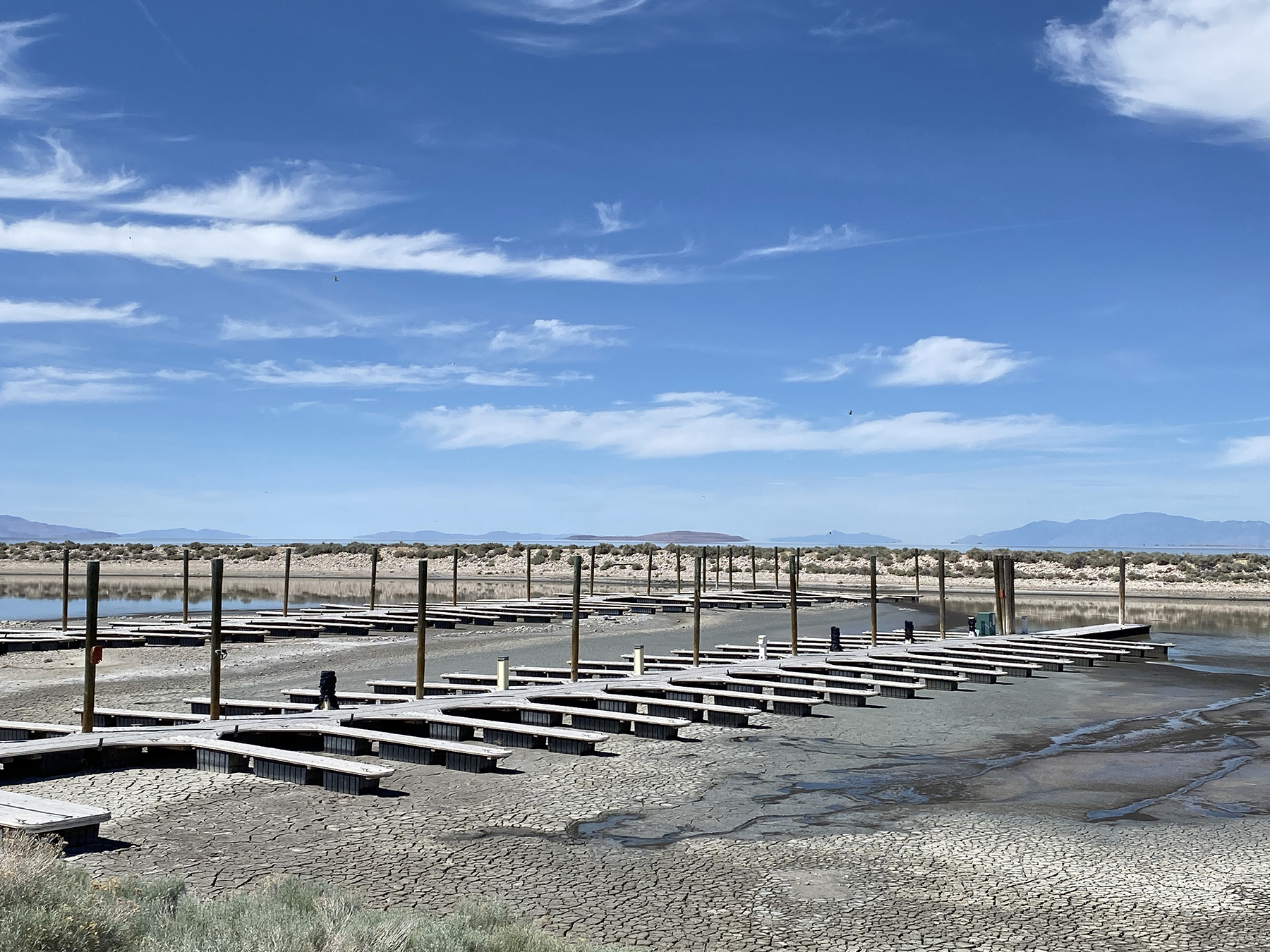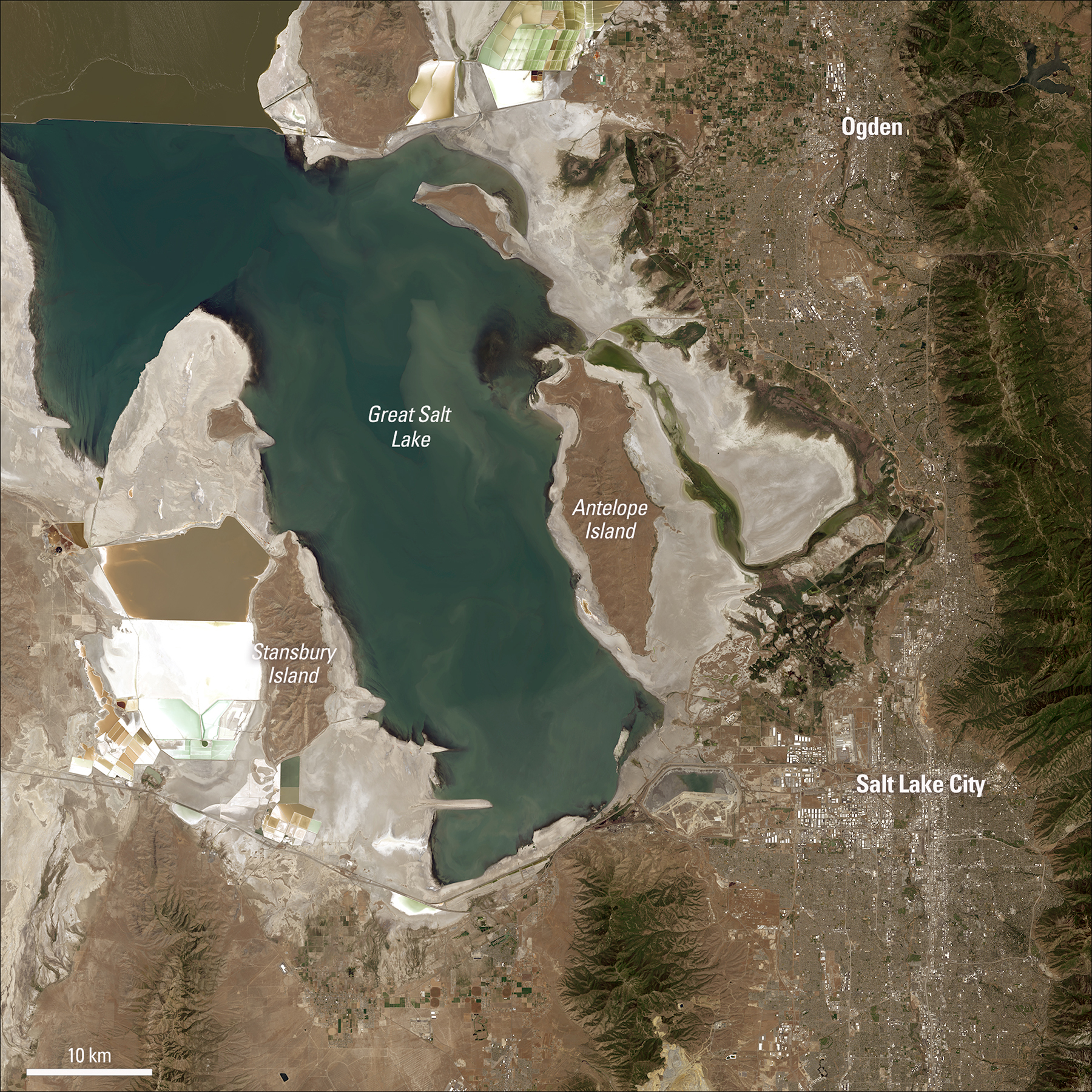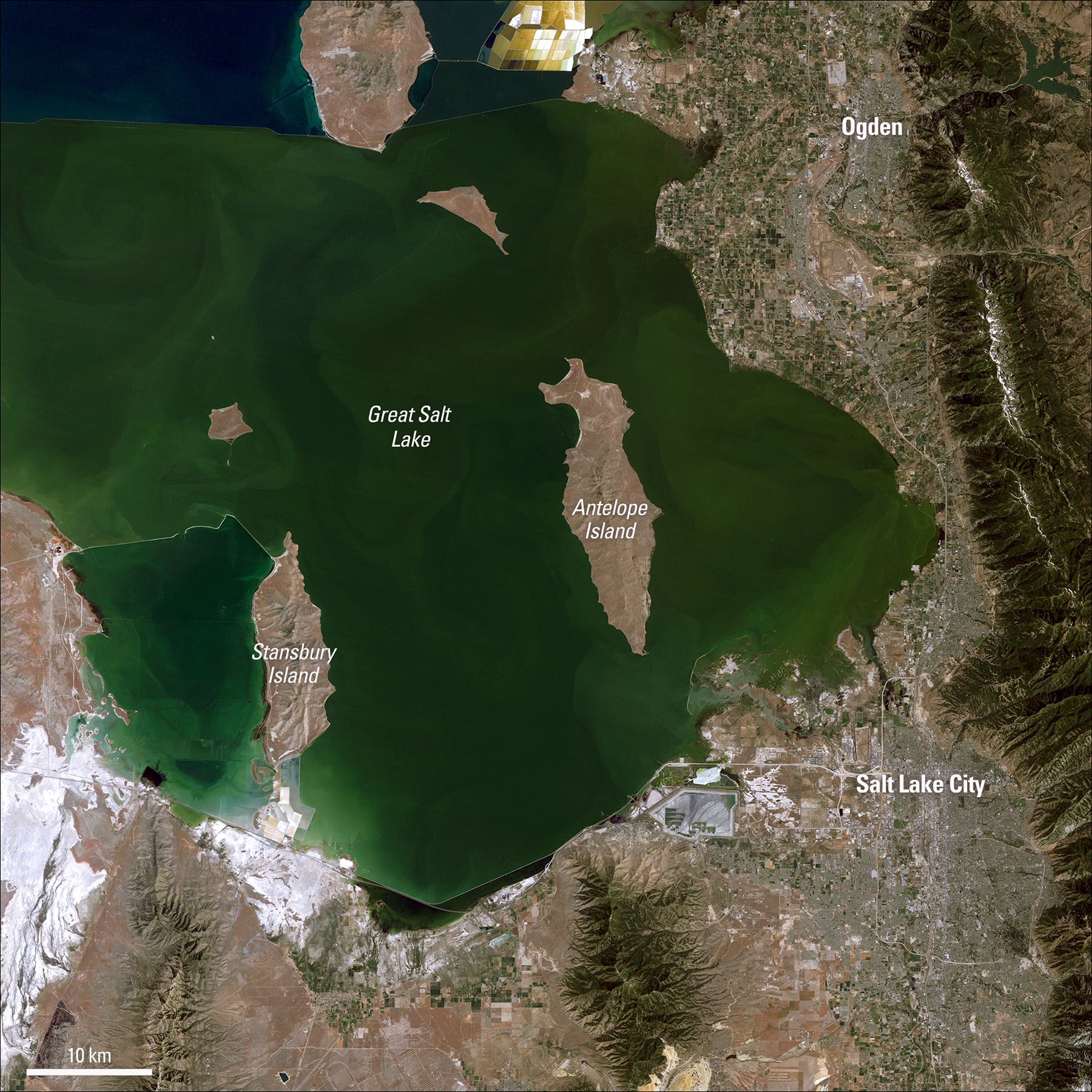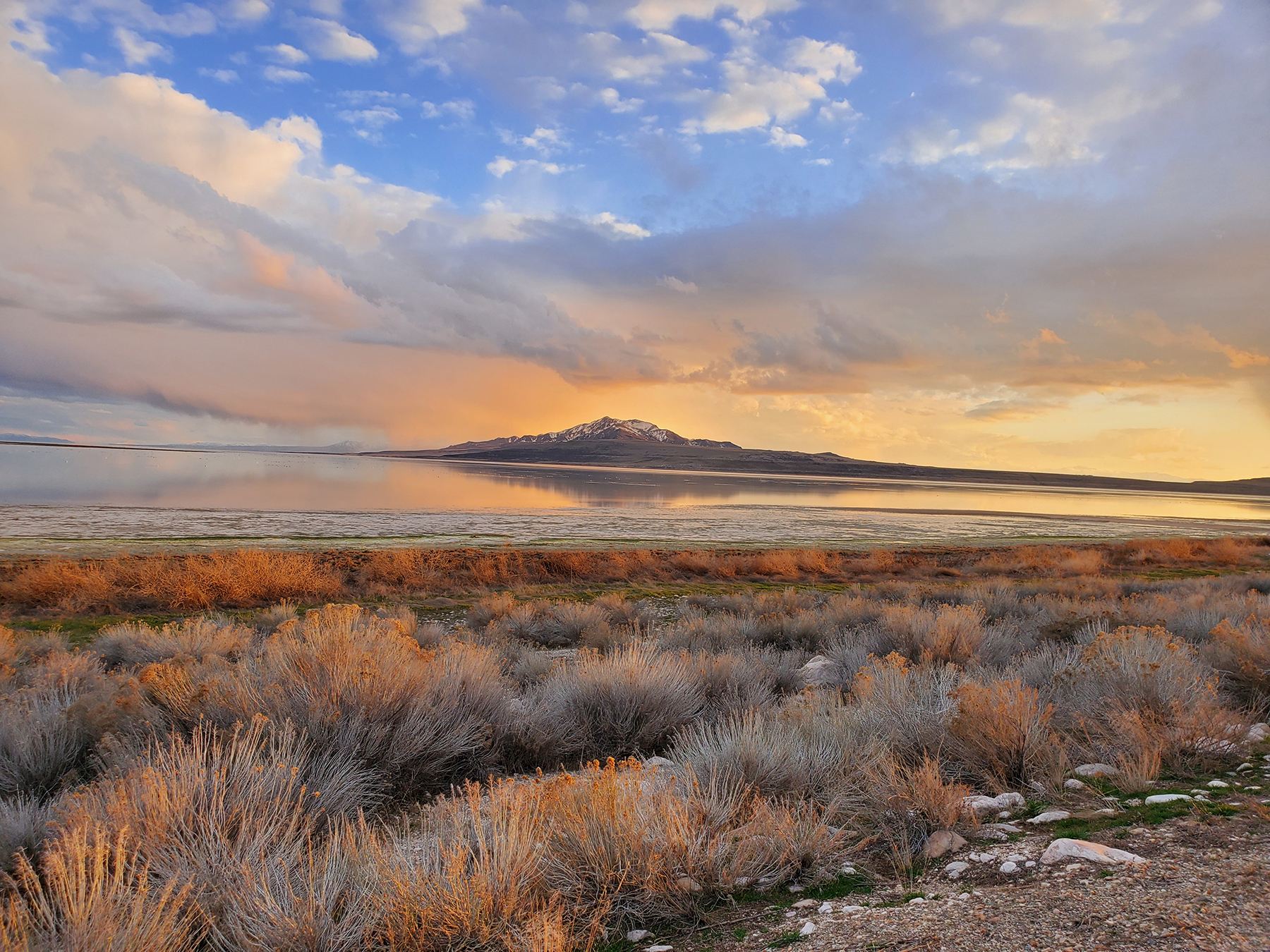By Jay Landers
Absent drastic action, Utah’s Great Salt Lake faces a dire future. North America’s largest saline lake has lost enormous volumes of water, as flows that otherwise would enter the terminal water body increasingly are diverted for agricultural, industrial, and municipal use. A vastly diminished Great Salt Lake poses critical threats to the environment, the regional economy, and human health. Of particular concern is the prospect of significant air pollution caused by winds transporting the salty crust from areas of dry lakebed, a long-term hazard that has accompanied the disastrous decline of other large saline lakes elsewhere.

Concerned by recent record-low water levels in the Great Salt Lake, a group of researchers issued a report in January, warning about the negative consequences to come and calling for extraordinary short-term measures to protect the lake and the region from ecological catastrophe. In early February, experts from Utah’s research universities released their own assessment, confirming the urgent nature of the situation and offering a mix of recommendations for policymakers to consider.
‘Uncharted territory’
The January report does not mince words about the perilous state of the Great Salt Lake. “At 19 feet below its average natural level since 1850, the lake is in uncharted territory,” according to the report. Titled Emergency measures needed to rescue Great Salt Lake from ongoing collapse, the report was released Jan. 4 by a group of researchers from multiple institutions, including Brigham Young University, Westminster College, Friends of Great Salt Lake, the University of Alberta, Utah State University, and Integral Consulting Inc. The lake “has lost 73% of its water and 60% of its surface area,” according to the report.

Since 2020, the Great Salt Lake has suffered an average deficit of 1.2 million acre-ft/yr. “If this loss rate continues, the lake as we know it is on track to disappear in five years,” the report notes.
Such an outcome would have disastrous environmental, economic, and human health consequences for the Salt Lake City region and beyond, says Benjamin Abbott, Ph.D., an assistant professor of plant and wildlife sciences at BYU and the lead author of the January report. “We are talking about an existential threat to our way of life,” Abbott says.
Saving the Great Salt Lake from such a fate will require drastic cuts in water consumption, according to the report.

“The lake needs an additional million acre-feet per year to reverse its decline,” the report states. This extra volume would increase average streamflow to the lake to approximately 2.5 million acre-ft/year, enabling the lake to refill gradually. “Depending on future weather conditions, achieving this level of flow will require cutting consumptive water use in the Great Salt Lake watershed by a third to a half.”
For these reasons, Utah’s governor needs “to implement a watershed-wide emergency rescue” and set an “emergency streamflow requirement of at least 2.5 million acre-feet per year until the lake reaches its minimum healthy elevation” of 4,198 ft above sea level, according to the report.
As of March 3, the elevation of the lake south of the railroad causeway that bifurcates it was 4,190.4 ft above sea level, according to the website of the Utah Division of Wildlife Resources. In 2022, the lake dipped to 4,188 ft, its lowest elevation on record.
Calls for conservation
The Great Salt Lake receives inflows from a 23 million-acre watershed that encompasses nearly all of northern Utah and small sections of Nevada, Idaho, and Wyoming. By far, agriculture constitutes the largest use of water in the watershed.
In fact, irrigation of alfalfa and other crops “directly accounts for around three quarters of total consumptive water use plus 5-10% indirectly through storage and transport losses such as reservoir evaporation,” according to the report. “Mineral extraction from the lake itself represents another 9% of water use. Cities and industry account for the final 9% of consumptive water use, of which 90% is outdoor water use (irrigation for lawns and other decorative plants). The remainder of the consumptive use comes from thermoelectric power production, mining, and other industrial processes.”
In the January report, the researchers call for water conservation in favor of water resource development. Conservation “is the only way to provide adequate water in time to save Great Salt Lake,” the report states. “Ensuring financial, legislative, and technical support for conservation will pay huge dividends during this crisis and for decades to come.”
That said, Abbott acknowledges that conservation will require drastic short-term cuts to current levels of consumptive water use in the Great Salt Lake watershed. “It's about a 30 to 50% decrease,” he says. “Those are big numbers.”
Although he supports the development of more water-efficient agricultural practices, Abbott views such efforts as long-term measures. Given the dire condition of the Great Salt Lake, short-term measures must be taken to divert water from agriculture to the lake, he says. “That’s the emergency rescue part of this equation,” he says. “In addition to those long-term measures to improve agricultural water-use efficiency, we also need to work with the agricultural community to have massive releases of water this year.”
The researchers call on the Utah government to facilitate and fund large-scale leasing or purchasing of water from farmers, water that can be dedicated to refilling the lake. Such “extraordinary short-term measures” are necessary “for the next two, three, or four years while we get out of this really, really bad place,” Abbott says.
Encouraging farmers to lease their water rights on a short-term basis would be preferable to buying their water rights outright and fallowing farmland, says Carly Burton, the executive director of the Utah Water Users Association, which represents agriculture interests, irrigation companies, municipalities, and other large water users in the state. “I like the idea of leasing surplus water rather than drying up farmland,” Burton says.
However, if the leasing concept is to succeed, Abbott acknowledges that more work is needed to facilitate the practice of “water shepherding,” or ensuring that water that is intended for the Great Salt Lake actually makes it to the lake and is not diverted by another downstream user. “That kind of monitoring and legal framework for transferring rights is still being developed,” Abbott says. “It's not quite ready for prime time yet.”
Another assessment
On Feb. 8, the Great Salt Lake Strike Team — a coalition of experts from Utah’s public research universities — released its report titled the Great Salt Lake Policy Assessment. In its report, the team called for “urgent action” to stave off the threats to economic activity, local public health, and ecosystems posed by the lake’s declining water levels. However, the team stopped short of advocating the sort of emergency measures called for in the January report.
Instead, the team identified 11 policy options for increasing water deliveries to the lake. Of these, two entail engineering solutions, seven involve measures for conserving water, and two concern new water sources.
One of the proposed engineering solutions calls for raising an existing berm that controls the flow of water between the causeway separating the north and south arms of the lake. Because most of the freshwater inflows to the lake enter the south arm, raising the berm to restrict the flow of water between the two arms would increase the elevation and decrease the salinity of the south arm.
The other engineering solution entails implementing dust-control measures on exposed portions of the lakebed.
Among the conservation measures is agriculture water optimization, including the improvement of systems used to convey water to farms. “Reductions of approximately 10-15% in water consumption could be achieved through on-farm optimization without reducing production,” potentially supplying nearly 180,000 acre-ft/year to the lake, according to the assessment.
Other conservation measures include optimizing municipal and industrial water pricing to reduce demand, promoting greater efficiency among municipal and industrial water users, and facilitating greater use of water banking and leasing. The latter option, which could involve the state leasing water for the lake, potentially could provide between 200,000 and 300,000 acre-ft/year to the lake, according to the assessment.
Potential consequences
Along with providing critical habitat for migratory birds and many other species, the Great Salt Lake is a linchpin of the Utahan economy, providing approximately $2.5 billion in annual economic productivity and supporting about 9,000 local jobs, the January report notes.
“These direct benefits come primarily from mineral extraction, recreation, and brine shrimp harvesting,” the January report notes. “Evaporation from Great Salt Lake increases annual snowfall in nearby mountains by 5-10%, supporting another 20,000 jobs and an additional $1.8 billion in annual economic activity.”
The lake’s decline puts these economic activities at risk while at the same time threatening to cause even greater problems. “The loss of evaporation from the lake can modify nearby climate, producing more extreme temperature swings, desertification, and further reduction of runoff,” the report says. “Together these effects can severely harm communities in the watershed of a shrinking lake, triggering abrupt crashes of lake industries, suppression of property values, mass migration, and social conflict associated with the loss of jobs, cultural identity, and quality of life.”

Air pollution is another key concern. As it recedes, the shrinking Great Salt Lake leaves behind ever-larger expanses of former lakebed that become salty crust. Over time, the crust erodes into dust that then is spread by winds, an outcome that could have dramatic repercussions in the Salt Lake City region if not curtailed.
In previous cases of saline lakes that were drained by human activity, the resulting wind-borne pollutants severely affected human health, says John Richard Saylor, Ph.D., a professor of mechanical engineering at Clemson University and the author of Lakes: Their Birth, Life, and Death, a 2022 book examining various lakes around the world. As examples, Saylor points to the Aral Sea between Kazakhstan and Uzbekistan and Owens Lake in California.
Once one of the largest lakes in the world, the Aral Sea in the then-Soviet Union was effectively drained over time by large-scale irrigation diversions implemented decades ago. Owens Lake in California mostly dried up following the diversion of its water sources to the Los Angeles Aqueduct in the early 20th century.
In both cases, windborne dispersal of particulate matter from the dry lakebeds led to “all kinds of respiratory health issues in people in the surrounding area,” Saylor says.
In the case of the Aral Sea, the problem was “compounded” by the significant amounts of pesticides and herbicides that had collected in the lake and accumulated in its sediment, Saylor says. The presence of such chemicals will “only exacerbate the pulmonary health issues that can arise” from the dispersal of dry lakebed particulate matter, he says.
The January report notes that arsenic, cadmium, mercury, nickel, chromium, lead, copper, selenium, organic contaminants, and cyanotoxins have been found in the sediment of the Great Lake. “These pollutants can be transported by dust particles smaller than 10 microns,” the report states.
Although there is no shortage of options to pursue to protect the Great Salt Lake, Abbott is concerned that anything done ultimately will be too little, too late.
“The big outstanding question is, ‘Are we going to do this in time and prevent catastrophe? Or are we going to let this go and then deal with all the inefficiencies of salvage and triage at the end?’” Abbott asks.
This article first appeared in Civil Engineering Online.



